Rheological Contrast between Quartz and Coesite Generates Strain Localization in Deeply Subducted Continental Crust
Abstract
:1. Introduction
2. Geological Setting and Samples
3. Methods
4. Petrography and Microstructure
4.1. Eclogite
4.2. Garnet Clinopyroxenite
4.3. Garnet Peridotite
4.4. Coesite Bearing Jadeite Quartzite
5. Mineral Chemistry
6. Crystallographic Preferred Orientations
7. Discussion
7.1. Deformation Mechanism
7.1.1. Garnet
7.1.2. Clinopyroxene
7.1.3. Quartz
7.1.4. Olivine
7.2. Preservation of Deformation Microstructures during UHP Metamorphism
7.3. Microstructural Evolution of UHP Metamorphic Rocks in the Dabie–Shan Region
8. Conclusions
Supplementary Materials
Author Contributions
Funding
Data Availability Statement
Acknowledgments
Conflicts of Interest
References
- Chopin, C. Coesite and pure pyrope in high-grade blueschists of the Western Alps: A first record and some consequences. Contrib. Mineral. Petrol. 1984, 86, 107–118. [Google Scholar] [CrossRef]
- Smith, C.D. Coesite in clinopyroxene in the Caledonides and its implications for geodynamics. Nature 1984, 310, 641–644. [Google Scholar] [CrossRef]
- Sobolev, N.V.; Shatsky, V.S. Diamond inclusions in garnets from metamorphic rocks: A new environment for diamond formation. Nature 1990, 343, 742–746. [Google Scholar] [CrossRef]
- Xu, Z.; Wang, Q.; Tang, Z.; Chen, F. Fabric kinematics of the ultrahigh-pressure metamorphic rocks from the main borehole of the Chinese Continental Scientific Drilling Project: Implications for continental subduction and exhumation. Tectonophysics 2009, 475, 235–250. [Google Scholar] [CrossRef]
- Zhang, R.Y.; Liou, J.G.; Ernst, W.G. The Dabie-Sulu continental collision zone: A comprehensive review. Gondwana Res. 2009, 16, 1–26. [Google Scholar] [CrossRef]
- Nakamura, D.; Hirajima, T. Granulite-facies overprinting of ultrahigh-pressure metamorphic rocks, northeastern Su-Lu region, eastern China. J. Petrol. 2000, 41, 563–582. [Google Scholar] [CrossRef] [Green Version]
- Zhang, R.Y.; Liou, J.G.; Yang, J.S.; Yui, T.-F. Petrochemical constraints for dual origin of garnet peridotites form the Dabie-Sulu UHP terrane, eastern-central China. J. Metamorph. Geol. 2000, 18, 149–166. [Google Scholar] [CrossRef]
- Liu, X.W.; Jin, Z.-M.; Green, H.W. Clinoenstatite exsolution in diopsidic augite of Dabieshan: Garnet peridotite from depth of 300 km. Am. Mineral. 2007, 92, 546–552. [Google Scholar] [CrossRef]
- Cong, B.L. Ultrahigh-Pressure Metamorphic Rocks in the Dabieshan-Sulu Region of China; Science Press: Beijing, China, 1996; 226p. [Google Scholar]
- Hacker, B.R.; Ratschbacher, L.; Webb, L.; Ireland, T.; Walker, D.; Dong, S. U/Pb zircon ages constrain the architecture of the ultrahigh-pressure Qinling-Dabie Orogen, China. Earth Planet. Sci. Lett. 1998, 161, 215–230. [Google Scholar] [CrossRef]
- Hacker, B.R.; Ratschbacher, L.; Webb, L.; McWilliams, M.O.; Ireland, T.; Calvert, A.; Shuwen, D.; Wenk, H.-R.; Chateigner, D. Exhumation of ultrahigh-pressure continental crust in East-central China: Late Triassic-Early Jurassic tectonic unroofing. J. Geophys. Res. 2000, 105, 13339–13364. [Google Scholar] [CrossRef] [Green Version]
- Li, X.P.; Zheng, Y.-F.; Wu, Y.B.; Chen, F.K.; Gong, B.; Li, Y.L. Low-T eclogite in the Dabie terrane of China: Petrological and isotopic constraints on fluid activity and radiometric dating. Contrib. Mineral. Petrol. 2004, 148, 443–470. [Google Scholar] [CrossRef]
- Okay, A.I.; Xu, S.; Sengör, A.M.C. Coesite from the Dabie Shan eclogites, central China. Eur. J. Mineral. 1989, 1, 595–598. [Google Scholar] [CrossRef]
- Wang, X.M.; Liou, J.G.; Mao, H.K. Coesite-bearing eclogites from the Dabie mountains in central China. Geology 1989, 17, 1085–1088. [Google Scholar] [CrossRef]
- Hirajima, T.; Ishiwatari, A.; Cong, B.; Zhang, R.Y.; Banno, S.; Nozaka, T. Identification of coesite in Mengzhong eclogite from Donghai county, northeastern Jiangsu Province, China. Mineral. Mag. 1990, 45, 579–583. [Google Scholar] [CrossRef] [Green Version]
- Zhang, R.Y.; Liou, J.G. Coesite-bearing eclogite in Henan Province, central China: Detailed petrography, glaucophane stability and PT-path. Eur. J. Mineral. 1994, 6, 217–234. [Google Scholar] [CrossRef] [Green Version]
- Zhang, R.Y.; Liou, J.G.; Cong, B.L. Talc-, Magnesite- and Ti-Clinohumite-Bearing Ultrahigh-Pressure Meta-Mafic and Ultramafic Complex in the Dabie Mountains, China. J. Petrol. 1995, 36, 1011–1037. [Google Scholar] [CrossRef]
- Zheng, Y.-F.; Fu, B.; Gong, B.; Li, L. Stable isotope geochemistry of ultrahigh pressure metamorphic rocks from the Dabie-Sulu orogen in China: Implications for geodynamics and fluid regime. Earth Sci. Rev. 2003, 62, 105–161. [Google Scholar] [CrossRef]
- Zheng, Y.-F.; Zhou, J.-B.; Wu, Y.-B.; Xie, Z. Low-grade metamorphic rocks in the Dabie-Sulu orogenic belt: A passive-margin accretionary wedge deformed during continent subduction. Int. Geol. Rev. 2005, 47, 851–871. [Google Scholar] [CrossRef]
- Xu, S.T.; Okay, A.I.; Ji, S.; Sengör, A.M.C.; Wen, S.; Liu, Y.C.; Jiang, L.L. Diamond from the Dabie Shan Metamorphic Rocks and Its implication for Tectonic Setting. Science 1992, 256, 80–82. [Google Scholar]
- Okay, A.I. Petrology of a diamond and coesite-bearing metamorphic terrain: Dabie Shan, China. Eur. J. Mineral. 1993, 5, 659–675. [Google Scholar] [CrossRef]
- Sobolev, N.V.; Shatskii, V.S.; Vavilov, M.A.; Goryainov, S.V. Zircon from high-pressure metamorphic rocks of folded regions as an unique container of inclusions of diamond, koesite and coexisting minerals. Dokl. Akad. Nauk 1994, 334, 488–492. [Google Scholar]
- Zhang, R.Y.; Hirajima, T.; Banno, S.; Cong, B.; Liou, J.G. Petrology of ultrahigh-pressure rocks from the southern Su-lu region, eastern China. J. Metamorph. Geol. 1995, 13, 659–675. [Google Scholar] [CrossRef]
- Carswell, D.A.; Wilson, R.N.; Zhai, M. Metamorphic evolution, mineral chemistry and thermobarometry of schists and orthogneisses hosting ultra-high pressure eclogites in the Dabieshan of central China. Lithos 2000, 52, 121–155. [Google Scholar] [CrossRef]
- Chavagnac, V.; Jahn, B.-M. Coesite-bearing eclogites from the Bixiling Complex, Dabie Mountains, China: Sm-Nd ages, geochemical characteristics and tectonic implications. Chem. Geol. 1996, 133, 29–51. [Google Scholar] [CrossRef]
- Okay, A.I. Paragonite eclogites from Dabie Shan, China: Re-equilibrations during exhumation. J. Metamorph. Geol. 1995, 13, 449–460. [Google Scholar] [CrossRef]
- Wang, X.M.; Zhang, R.Y.; Liou, J.G. UHPM Terrane in East Central China. In Ultrahigh Pressure Metamorphism; Coleman, R.G., Wang, X., Eds.; Cambridge University Press: Cambridge, UK, 1995; pp. 356–390. [Google Scholar]
- Cong, B.L.; Zhai, M.G.; Carswell, D.A.; Wilson, R.N.; Wang, Q.C.; Zhao, Z.Y.; Windley, B.F. Petrogenesis of ultrahigh-pressure rocks and their country rocks at Shuanghe in the Dabie Mountains, Central China. Eur. J. Mineral. 1995, 7, 119–138. [Google Scholar]
- Carswell, D.A.; O’Brien, P.J.; Wilson, R.N.; Zhai, M. Thermobarometry of phengite-bearing eclogites in the Dabie Mountains of central China. J. Metamorph. Geol. 1997, 15, 239–252. [Google Scholar] [CrossRef]
- Shi, Y.; Wang, Q. Variation in peak P-T conditions across the upper contact of the UHP terrane, Dabieshan, China: Gradational or abrupt? J. Metamorph. Geol. 2006, 24, 803–822. [Google Scholar] [CrossRef]
- Liou, J.G.; Zhang, R.Y. Significance of ultrahigh-P talc-bearing eclogite assemblages. Mineral. Mag. 1995, 59, 93–102. [Google Scholar] [CrossRef]
- Xiao, Y.L.; Hoefs, J.; van den Kerkhof, A.M.; Fiebig, J.; Zheng, Y.F. Fluid history of UHP metamorphism in Dabie Shan, China: A fluid inclusion and oxygen isotope study on the coesite-bearing eclogite from Bixiling. Contrib. Mineral. Petrol. 2000, 139, 1–16. [Google Scholar] [CrossRef]
- Zheng, J.P.; Sun, M.; Griffin, W.L.; Zhou, M.F.; Zhao, G.C.; Robinson, P.; Tang, H.Y.; Zhang, Z.H. Age and geochemistry of contrasting peridotite types in the Dabie UHP belt, eastern China: Petrogenetic and geodynamic implications. Chem. Geol. 2008, 247, 282–304. [Google Scholar] [CrossRef]
- Wang, L.; Jin, Z.M.; Kusky, T.; Xu, H.J.; Liu, X.W. Microfabric characteristics and rheological significance of ultra-high-pressure metamorphosed jadeite-quartzite and eclogite from Shuanghe, Dabie Mountains, China. J. Metamorph. Geol. 2010, 28, 163–182. [Google Scholar] [CrossRef]
- Bachmann, F.; Hielscher, R.; Schaeben, H. Texture Analysis with MTEX–Free and Open Source Software Toolbox. Solid State Phenom. 2010, 160, 63–68. [Google Scholar] [CrossRef] [Green Version]
- Bunge, H.J. Texture Analysis in Materials Science; Butterworths: London, UK, 1982; 593p. [Google Scholar]
- Michibayashi, K.; Mainprice, D. The role of pre-existing mechanical anisotropy on shear zone development within oceanic mantle lithosphere: An example from the Oman ophiolite. J. Petrol. 2004, 45, 405–414. [Google Scholar] [CrossRef] [Green Version]
- Arai, S. Characterization of spinel peridotites by olivine-spinel compositional relationships: Review and interpretation. Chem. Geol. 1994, 113, 191–204. [Google Scholar] [CrossRef]
- Kleinschrodt, R.; McGrew, A. Garnet plasticity in the lower continental crust: Implications for deformation mechanisms based on microstructures and SEM electron channeling pattern analysis. J. Struct. Geol. 2000, 22, 795–809. [Google Scholar] [CrossRef]
- Kleinschrodt, R.; Duyster, J.P. HT-deformation of garnet: An EBSD study on granulites from Sri Lanka, India and the Ivrea Zone. J. Struct. Geol. 2002, 24, 1829–1844. [Google Scholar] [CrossRef]
- Storey, C.D.; Prior, D.J. Plastic deformation and recrystallization of garnet: A mechanism to facilitate diffusion creep. J. Petrol. 2005, 46, 2593–2613. [Google Scholar] [CrossRef] [Green Version]
- Vollbrecht, A.; Pawlowski, J.; Lesiss, B.; Heinrichs, T.; Seidel, M.; Kronz, A. Ductile deformation of garnet in mylonitic gneisses from the Münchberg Massif (Germany). Tectonophysics 2006, 427, 153–170. [Google Scholar] [CrossRef]
- Puelles, P.; Bbalos, B.; Gil Ibarguchi, J.I. Transposed high-pressure granulite fabrics (Cabo Ortegal, NW Spain): Implications on the scales of deformation localization. J. Struct. Geol. 2009, 31, 776–790. [Google Scholar] [CrossRef]
- Keppler, R. Crystallographic preferred orientations in eclogites—A review. J. Struct. Geol. 2018, 115, 284–296. [Google Scholar] [CrossRef]
- Terry, M.P.; Heidelbach, F. Superplasticity in garnet from eclogite facies shear zones in the Haram Gabbro, Haramsøya, Norway. Geology 2004, 32, 281–284. [Google Scholar] [CrossRef]
- Mainprice, D.; Bascou, J.; Cordier, P.; Tommasi, A. Crystal preferred orientations of garnet: Composition between numerical simulations and electron back-scattered diffraction (EBSD) measurements in naturally deformed eclogites. J. Struct. Geol. 2004, 26, 2089–2102. [Google Scholar] [CrossRef]
- Zhang, J.; Green, H.W.; Bozhilov, K. Rheology of omphacite at high temperature and pressure and significance of its lattice preferred orientations. Earth Planet. Sci. Lett. 2006, 246, 432–443. [Google Scholar] [CrossRef]
- Chen, S.; Hiraga, T.; Kohlstedt, D.L. Water weakening of clinopyroxene in the dislocation creep regime. J. Geophys. Res. 2006, 111, B08203. [Google Scholar] [CrossRef] [Green Version]
- Orzol, J.; Stockhert, B.; Trepmann, C.A.; Rummel, F. Experimental deformation of synthetic wet jadeite aggregates. J. Geophys. Res. 2006, 111, B06205. [Google Scholar] [CrossRef] [Green Version]
- Tullis, J. Deformation of granitic rocks: Experimental studies and natural examples. Rev. Mineral. Geochem. 2002, 51, 51–95. [Google Scholar] [CrossRef]
- Passchier, C.W.; Trouw, R.A.J. Microtectonics, 2nd ed.; Revised and Enlarged Edition; Springer: Berlin, Germany, 2005; 366p. [Google Scholar]
- Blumefeld, P.; Mainprice, D.; Bouchez, J.L. C-slip in quartz from subsolidus deformed granite. Tectonophysics 1986, 127, 96115. [Google Scholar]
- Mainprice, D.; Bouchez, J.L.; Blumenfeld, P.; Tubié, J.M. Dominant c slip in naturally deformed quartz: Implications for dramatic plastic softening at high temperature. Geology 1986, 14, 819–822. [Google Scholar] [CrossRef]
- Zhang, J.F.; Shi, F.; Xu, H.J.; Wang, L.; Feng, S.Y.; Liu, W.L.; Wang, Y.F.; Green, H.W. Petrofabric and strength of SiO2 near the quartz-coesite phase boundary. J. Metamorph. Geol. 2013, 31, 83–92. [Google Scholar] [CrossRef]
- Renedo, R.N.; Nachlas, W.O.; Whitney, D.L.; Teyssier, C.; Piazolo, S.; Gordon, M.S.; Fossen, H. Fabric development during exhumation from ultrahigh-pressure in an eclogite-bearing shear zone, Western Gneiss Region, Norway. J. Struct. Geol. 2015, 71, 58–70. [Google Scholar] [CrossRef]
- Jung, H.; Karato, S. Water-induced fabric transitions in olivine. Science 2001, 293, 1460–1463. [Google Scholar] [CrossRef] [PubMed] [Green Version]
- Katayama, I.; Jung, H.; Karato, S. New type of olivine fabric at modest water content and low stress. Geology 2004, 32, 1045–1048. [Google Scholar] [CrossRef] [Green Version]
- Karato, S.; Jung, H.; Katayama, I.; Skemer, P.A. Geodynamic significance of seismic anisotropy of the upper mantle: New insights from laboratory studies. Annu. Rev. Earth Planet. Sci. 2008, 36, 59–95. [Google Scholar] [CrossRef] [Green Version]
- Li, C.; Thakurta, J.; Ripley, E.M. Low-Ca contents and kink-banded textures are not unique to mantle olivine: Evidence from the Duke Island Complex, Alaska. Mineral. Petrol. 2012, 104, 147–153. [Google Scholar] [CrossRef]
- Jenkins, M.C.; Mungall, J.E. Genesis of the peridotite zone, Stillwater Complex, Montana, USA. J. Petrol. 2018, 59, 2157–2189. [Google Scholar] [CrossRef]
- Yao, Z.; Qin, K.; Wang, Q.; Xue, S. Weak B-type Olivine Fabric Induced by Fast Compaction of Crystal Mush in a Crustal Magma Reservoir. J. Geophys. Res. Solid Earth 2019, 124, 3530–3556. [Google Scholar] [CrossRef]
- Cao, Y.; Jung, H.; Song, S. Olivine fabrics and tectonic evolution of fore-arc mantles: A natural perspective from the Songshugou dunite and harzburgite in the Qinling orogenic belt, central China. Geochem. Geophys. Geosys. 2017, 18, 907–934. [Google Scholar] [CrossRef]
- Sundberg, M.; Cooper, R.F. Crystallographic preferred orientation produced by diffusion creep of harzburgite: Effect of chemical interactions among phases during plastic flow. J. Geophys. Res. 2008, 113, B12208. [Google Scholar] [CrossRef]
- Précigout, J.; Hirth, G. B-type olivine fabric induced by grain boundary sliding. Earth Planet. Sci. Lett. 2014, 395, 231–240. [Google Scholar] [CrossRef] [Green Version]
- Ji, S.; Saruwatari, K.; Mainprice, D.; Wirth, R.; Xu, Z.; Xia, B. Microstructures, petrofabrics and seismic properties of ultra high-pressure eclogites from Sulu region, China: Implications for rheology of subducted continental crust and origin of mantle reflections. Tectonophysics 2003, 370, 49–76. [Google Scholar] [CrossRef]
- Bestmann, M.; Habler, G.; Heidelbach, F.; Theni, M. Dynamic recrystallization of garnet and related diffusion processes. J. Struct. Geol. 2008, 30, 777–790. [Google Scholar] [CrossRef]
- Bestmann, M.; Prior, D.J. Intragranular dynamic recrystallization in naturally deformed calcite marble: Diffusion accommodated grain boundary sliding as a result of subgrain rotation recrystallization. J. Struct. Geol. 2003, 25, 1597–1613. [Google Scholar] [CrossRef]
- Gleason, G.C.; Tullis, J. A flow law for dislocation creep of quartz aggregates determined with the molten salt cell. Tectonophysics 1995, 247, 1–23. [Google Scholar] [CrossRef]
- Holyoke, C.W.; Kronenberg, A.K. Accurate differential stress measurement using the molten salt cell and solid salt assemblies in the Griggs apparatus with applications to strength, piezometers and rheology. Tectonophysics 2010, 494, 17–31. [Google Scholar] [CrossRef]
- Renner, J.; Stöckhert, B.; Zerbian, A.; Röller, K.; Rummel, F. An experimental study into the rheology of synthetic polycrystalline coesite aggregates. J. Geophys. Res. 2001, 106, 19411–19429. [Google Scholar] [CrossRef]
- Carswell, D.A.; Zhang, R.Y. Petrographic characteristics and metamorphic evolution of ultrahigh-pressure eclogites in plate-collision belts. Inter. Geol. Rev. 1999, 41, 781–798. [Google Scholar] [CrossRef]
- Jin, Z.-M.; Zhang, J.; Green, H.W., II; Jin, S. Eclogite rheology: Implications for subducted lithosphere. Geology 2001, 29, 667–670. [Google Scholar] [CrossRef]
- Warren, C.J. Exhumation of (ultra-)high-pressure terranes: Concepts and mechanisms. Solid Earth 2013, 4, 75–92. [Google Scholar] [CrossRef] [Green Version]
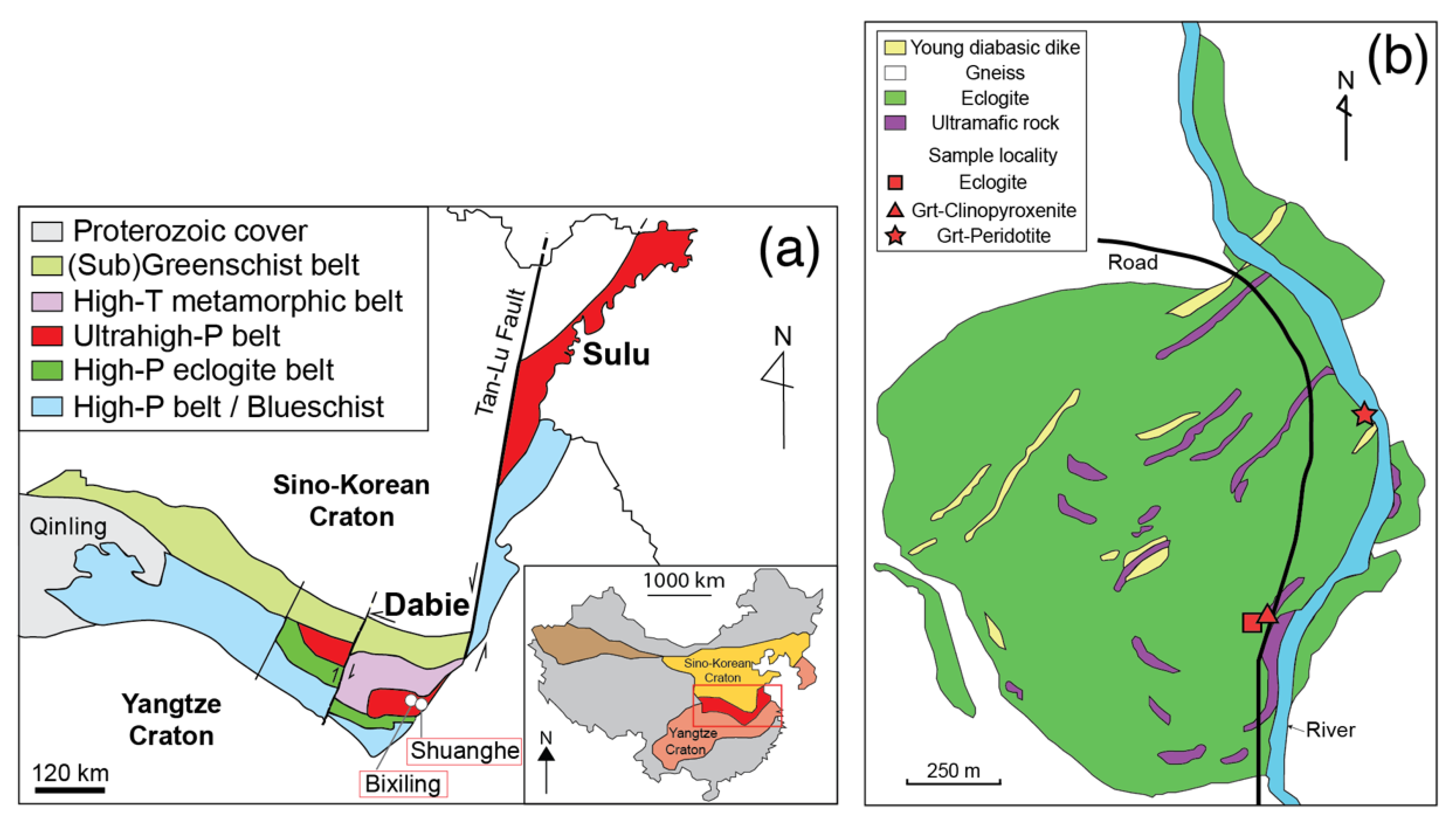
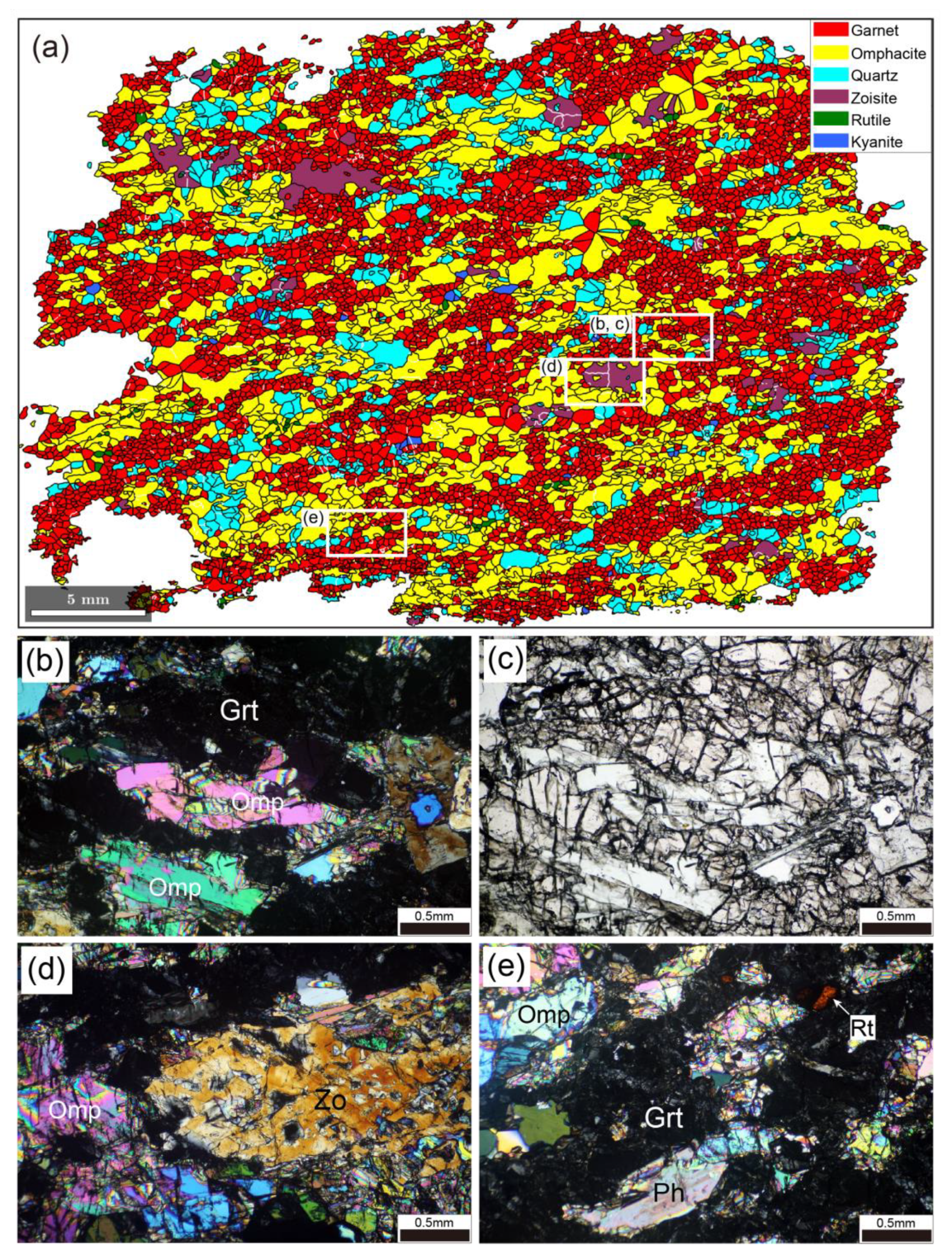

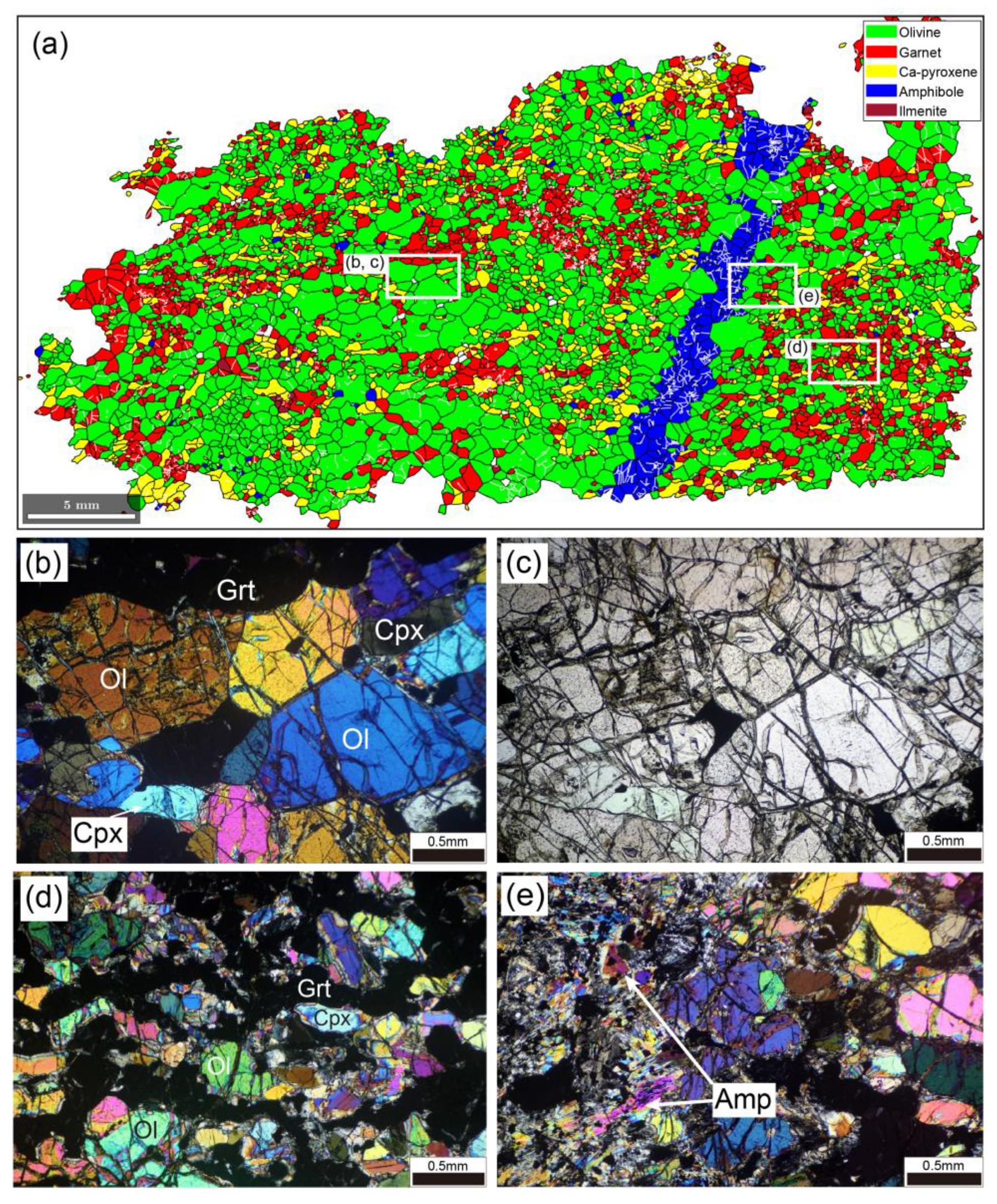
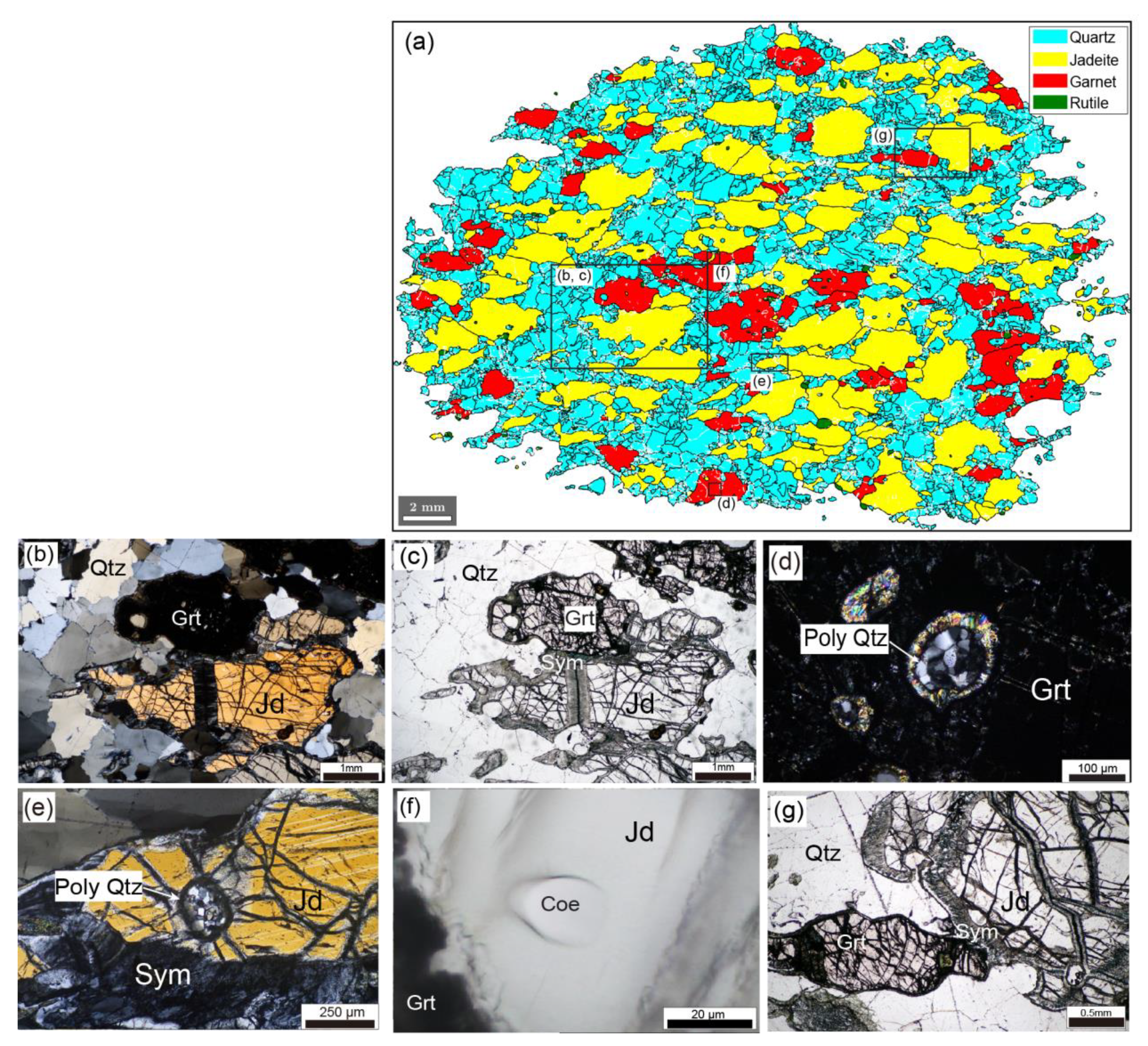
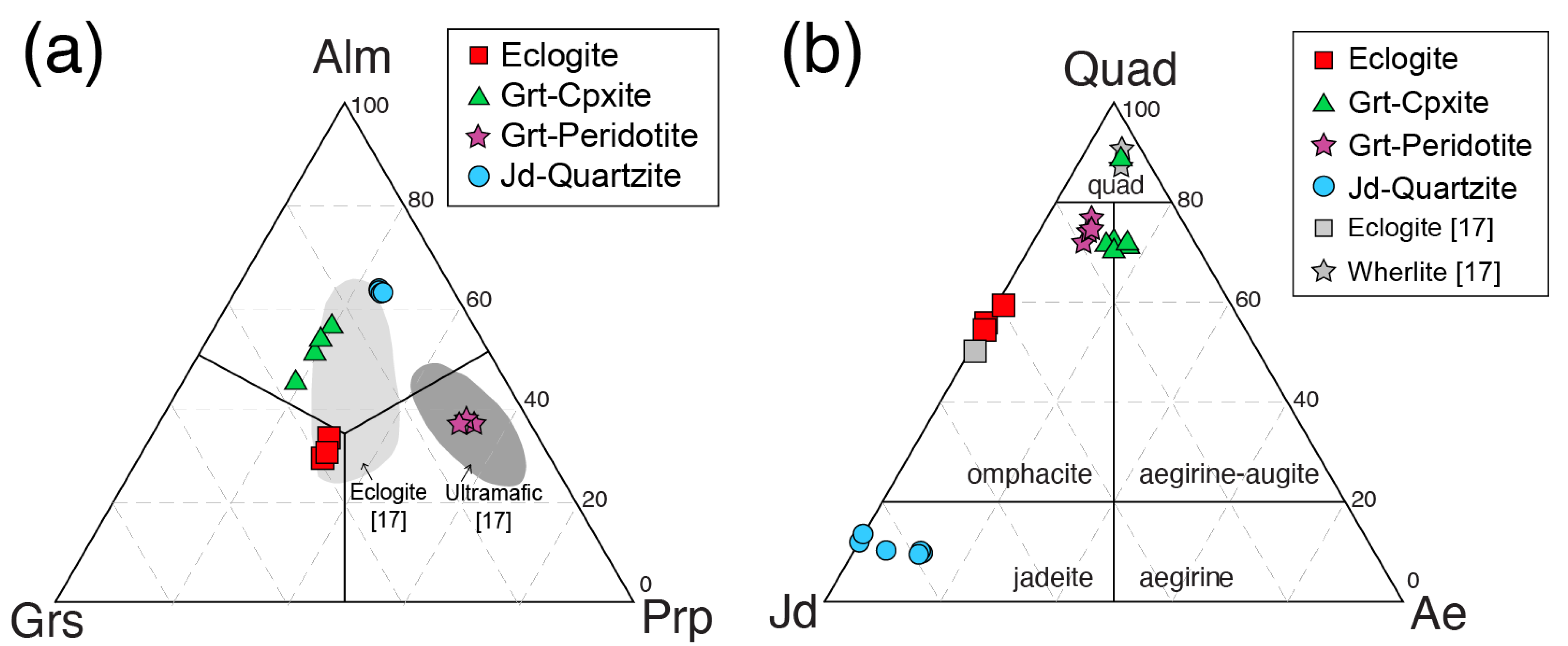
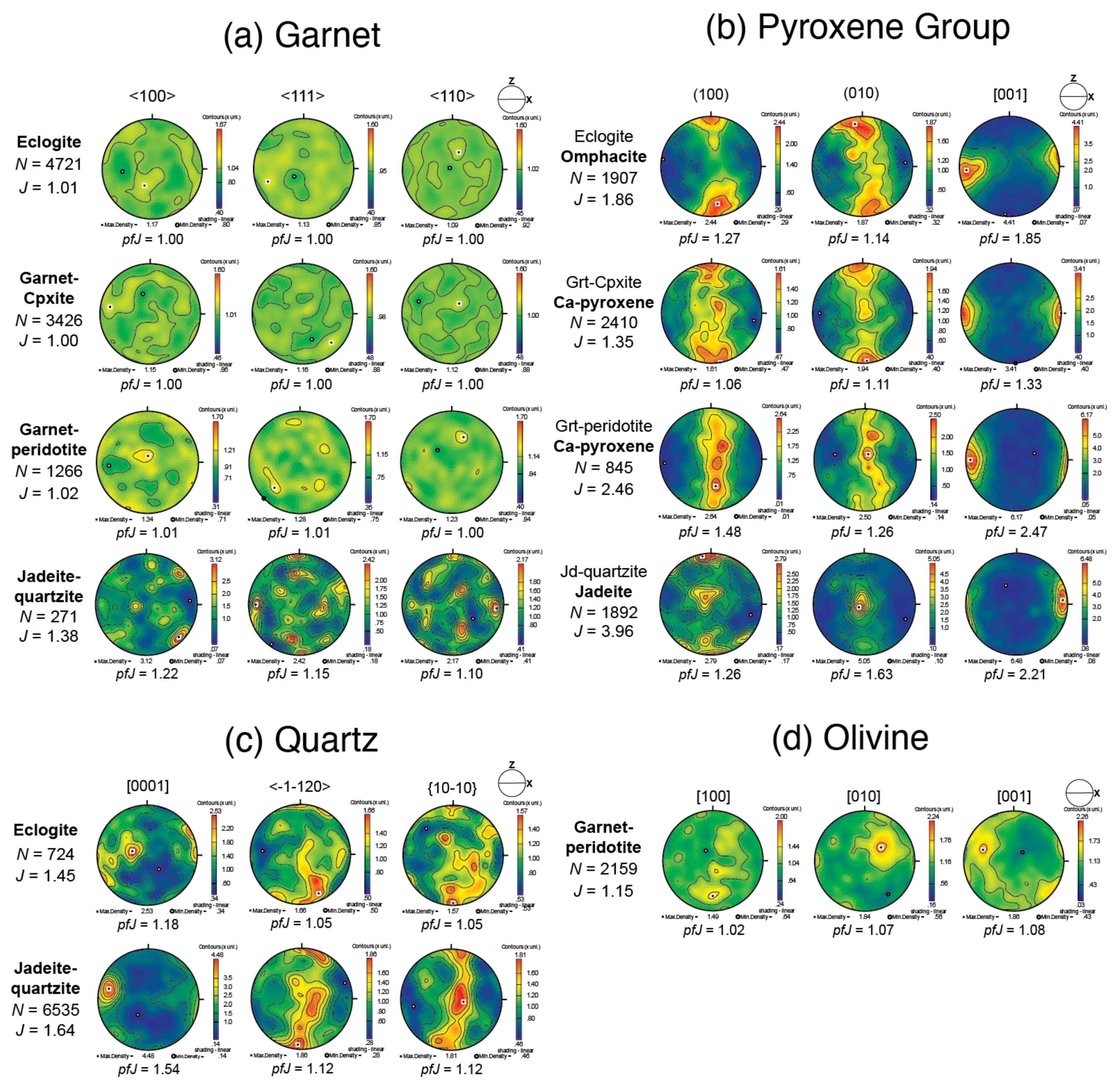
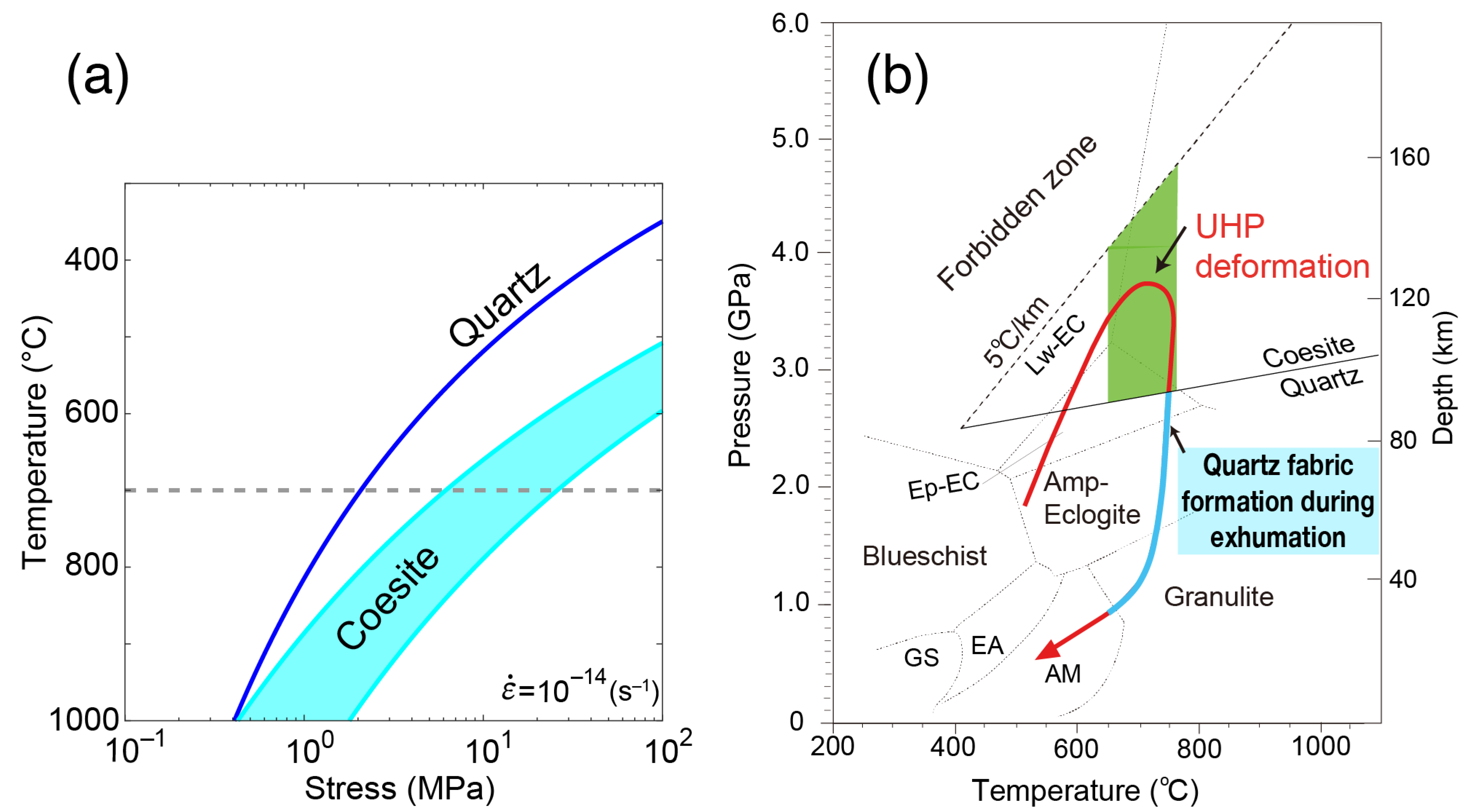
Publisher’s Note: MDPI stays neutral with regard to jurisdictional claims in published maps and institutional affiliations. |
© 2021 by the authors. Licensee MDPI, Basel, Switzerland. This article is an open access article distributed under the terms and conditions of the Creative Commons Attribution (CC BY) license (https://creativecommons.org/licenses/by/4.0/).
Share and Cite
Asano, K.; Michibayashi, K.; Takebayashi, T. Rheological Contrast between Quartz and Coesite Generates Strain Localization in Deeply Subducted Continental Crust. Minerals 2021, 11, 842. https://doi.org/10.3390/min11080842
Asano K, Michibayashi K, Takebayashi T. Rheological Contrast between Quartz and Coesite Generates Strain Localization in Deeply Subducted Continental Crust. Minerals. 2021; 11(8):842. https://doi.org/10.3390/min11080842
Chicago/Turabian StyleAsano, Kouhei, Katsuyoshi Michibayashi, and Tomohiro Takebayashi. 2021. "Rheological Contrast between Quartz and Coesite Generates Strain Localization in Deeply Subducted Continental Crust" Minerals 11, no. 8: 842. https://doi.org/10.3390/min11080842
APA StyleAsano, K., Michibayashi, K., & Takebayashi, T. (2021). Rheological Contrast between Quartz and Coesite Generates Strain Localization in Deeply Subducted Continental Crust. Minerals, 11(8), 842. https://doi.org/10.3390/min11080842






